Dundee, Broughty Ferry and District Tramways
History
After two failed attempts to build an electric tramway along the north shore of the Firth of Tay, a third attempt in 1904 — this time by George Balfour, who would later go on to form Balfour Beatty and Company Limited — proved successful. Powers were granted under the Dundee, Broughty Ferry and District Tramways Order Confirmation Act of 1904, which received its Royal Assent on the 15th August. The act also incorporated a company — the Dundee, Broughty Ferry and District Tramways Company — to construct, maintain and operate the electric tramway.
Contracts were let in April 1905, the opening taking place eight months later on the 27th December 1905. At the tramway's western end, its tracks met those of Dundee Corporation's system at the Burgh boundary (Craigie Terrace); however, and unlike many municipal authorities, which seem to have gone out of their way to prevent company-operated tramways from connecting to their own systems, Dundee appears to have had a much more enlightened attitude, viewing the new company line as an extension to its own system. As a result, mutual through running — between Dundee and Monifieth began on the opening day; although the early services involved a change of crew at the municipal boundary, this inefficiency was soon eliminated, crews working right through from February 1906.
The initial services were worked by twelve open-topped tramcars, which were joined by two top-covered cars in 1907, with two of the original fleet receiving top covers in 1909.
In late summer 1908, the tramway was extended at its eastern end by 300 yards, bringing it to its maximum extent of 5.5 miles. The DBF&DTCo's system consisted of a single route (mostly double track) running from the Dundee Burgh boundary at Craigie Terrace eastwards along Broughty Ferry Road, Stannergate Road, Craigie Drive (at the time a section of reserved tram track), Strathearn Road, Victoria Road and Claypots Road to Queen Street, Broughty Ferry. From here the tramway continued eastwards parallel to the Firth of Tay, through Reres Hill, Barnhill and Milton to a terminus in High Street, Monifieth; the original terminus was at the junction with Union Street, the 1908 extension taking it to Tay Street.
In 1914, Dundee Burgh was enlarged, the company reaching agreement that year to sell the corporation 1,514 yards of infrastructure (tracks and overhead) that lay within the new, expanded boundary.
The tramway was badly impacted by the Great War, suffering like most systems from a loss of workers (and their skills) to the armed forces, and restrictions on spares and new materials. This was compounded by a drop in revenue due to a combination of increased fares, and a loss of tourist and golfing traffic, which had always been an important component of the company's revenue. As a result, the tramway emerged from the conflict in badly run-down condition, which the company probably did its best to remedy, but without going to the expense of major track renewal.
The company's woes were added to on the 21st November 1921 when the corporation began a motorbus service between Dundee and Broughty Ferry, which though it did not run along the tramway route itself, threatened to abstract a significant number of passengers from the tramway. The company responded by seeking an injunction to stop the services, under powers it already held, finally putting paid to the corporation buses on the 8th July 1922.
In 1925, moves began within the corporation to acquire the DBF&DTCo's assets and to completely modernise the tramway; the full council, however, had other ideas, the motion being decisively defeated in early 1926. The company meanwhile continued its make-do-and-mend approach, buying two second-hand tramcars from the corporation in 1926, which had been built in 1900.
By the late 1920s, the tramway (both corporation and company services) were suffering significantly from independent motorbus competition, the company responding by seeking powers of its own (in 1928) that would enable it to join the fray. The company changed its name in 1928 — to the Dundee, Broughty Ferry and District Traction Company — in anticipation of the new powers, which were granted on the 26th July of the following year under the Dundee, Broughty Ferry and District Traction Order Confirmation Act 1929. The company and corporation then managed to disagree for almost a year over various aspects of a joint service between Dundee and Broughty Ferry, allowing yet more tramway passengers to drain away to the competing motorbuses. Although joint company-corporation motorbus services were finally introduced on the 16th June 1930, the company still had no motorbuses of its own, so ended up hiring them from the corporation.
The corporation's thoughts soon turned to buying the company out, and in February 1931, the company accepted the corporation's offer of £25,000. Some sense of the parlous state of the tramway, i.e., its decrepit track and ancient trams, and general financial viability, can be gauged from the difference between the accepted price, and what the corporation had proposed to offer (£85,000) five years previously.
The last trams over the DBF&DT ran on the 15th May 1931, the corporation closing it that day in favour of enhanced motorbus services.
The tramway had been relatively prosperous prior to the 1920s, paying dividends of between 3% and 7%, the latter being very much dependent on the weather (tourists and golfers). The company was wound up on the 7th April 1932.
Uniforms
Photographs taken in the first few months of operation show that staff wore single-breasted jackets with non-metallic buttons and lapels; these garments did not carry any insignia, and have the look of an interim measure, more than likely locally supplied. The peaked caps were of the tensioned-crown type; they bore a tall, oval metal cap badge of uncertain pattern (an example has yet to come to light), though it may well have utilised the same monogram the company used on its buttons and tram waist panels (see link). These badges are noticeably absent on photographs taken on the opening day, but appear shortly afterwards, suggesting that they had not been delivered in time for the inauguration of services.
By the late-Edwardian era, possibly earlier, a change had been made to the style of the uniforms. Motormen were now issued with double-breasted, lancer-style tunics with five pairs of buttons (narrowing from top to bottom), whilst conductors were provided with single-breasted jackets with five buttons and two breast pockets; both types of jacket bore epaulettes and stand-up collars, all devoid of insignia. Conductors' jacket sleeves were embellished with two small buttons; it is unclear whether motormen's jackets also had these.
Photographs taken around the time of the Great War suggest that both the jacket epaulettes and the large oval cap badge had been dispensed with; the latter were superseded by standard, script-lettering grade badges, either 'Motorman' or 'Conductor'. Photographic evidence suggests that this was not a wholesale replacement, so in all likelihood, it was a cost-saving measure for new orders. Grade badges could be bought 'off the shelf' from manufacturers, whereas bespoke badges would have had to have been pre-ordered, and were of course specific to the DBF&DTCo, and therefore more costly.
The style of uniform was altered one last time in the late 1920s, with both motormen and conductors now wearing single-breasted jackets with four buttons, two breast pockets (with button closures), epaulettes and lapels. Neither the epaulettes nor the lapels appear to have carried badges of any kind.
Conductors usually had an oval plate attached to their cash-bag straps; this was probably a cash-bag identity plate rather than a municipal licence badge.
Tramcar crews were initially provided with single-breasted greatcoats with five buttons and high fold-over collars; these garments also had vertical slit breast pockets closed by two buttons, an arrangement unique to this system. These garments were eventually superseded by double-breasted greatcoats with five pairs of buttons, and lapels. No badges of any kind were worn on either of the two types of greatcoat.
Photographs of inspectors are unfortunately extremely rare, those that have survived being from the latter years of operation, and all of the same individual. At this time, inspectors wore double-breasted jackets with four pairs of buttons, and lapels; the collars bore the grade — 'Inspector' — in embroidered script lettering. The peaked caps were of the tensioned-crown type; they bore a script-lettering grade badge, very probably embroidered upon a hat band.
Women were employed in small numbers during the Great War to replace male staff lost to the armed services; in stark contrast to the vast majority of British tramway systems, they continued to be employed (as conductresses) right through the 1920s. Female staff were issued with long, single-breasted jackets with five buttons, a waist belt (with button fastening), hip pockets and lapels, and matching skirts; once again, and in common with the men's jackets, they did not carry any insignia. Headgear came in two varieties: dark-coloured straw bonnets, presumably for summer wear, and baggy motor caps with glossy peaks, presumably for winter wear. The latter certainly bore standard, script-lettering 'Conductor' cap badges, whereas the situation with the bonnets is less clear, though they did bear a hat band.
Conductresses were also provided with single-breasted topcoats; these bore high, fold-over collars, and were once again without badges of any kind. In the mid-to-late 1920s, single-breasted, light-coloured gabardine-like coats were issued, very probably for summer use only.
Further reading
With grateful thanks to Alan Brotchie for help with the above information and photos. For a history of Dundee's tramways, see: 'Tramways of the Tay Valley' by A W Brotchie'; Dundee Museum and Art Gallery (1965).
Images
Motormen and conductors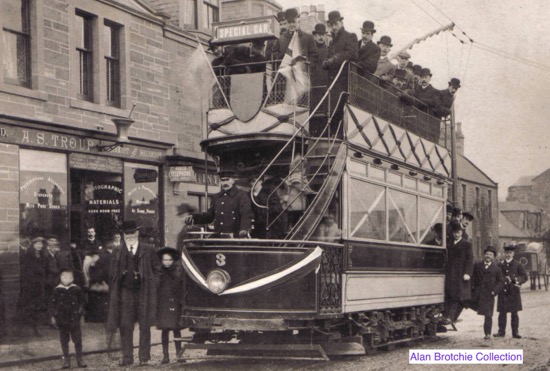
Tramcar No 3 loaded with dignitaries on the opening day, 27th December 1905.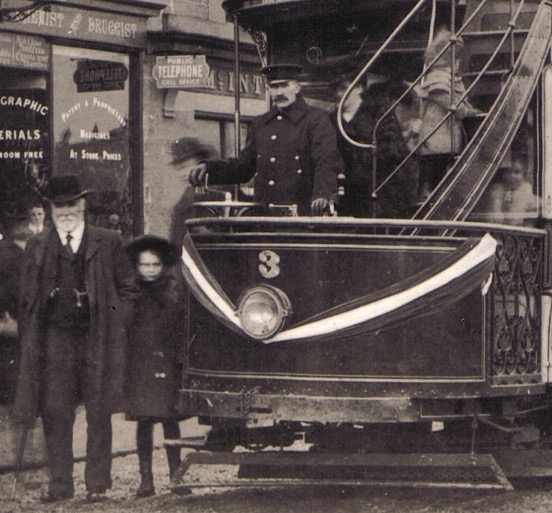
An enlargement of the above photograph showing the motorman; he is wearing a single-breasted greatcoat with a curious arrangement of two buttons on what would appear to be vertical slit breast pockets. Neither his coat nor his cap bear insignia. 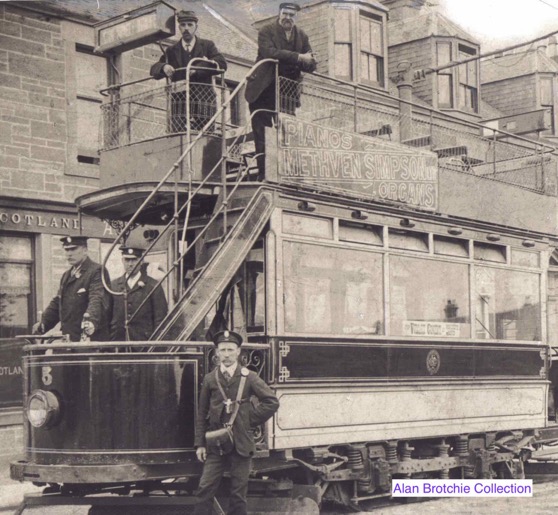
Three crewmen pose with Tramcar No 5 at the original terminus in Union Street, Monifieth — photo undated, but very probably taken in the first few months of operation.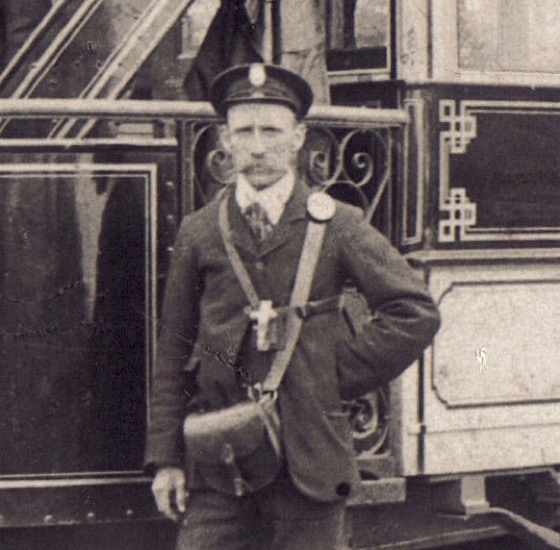
An enlargement of the above photograph showing the conductor. His jacket appears to bear plain composite or horn buttons which, given that two types of marked buttons have survived (see link), suggests that uniforms 'proper' had perhaps not arrived at the time the photograph was taken. His cap bears a tall oval cap badge (of unknown pattern) and his cash-bag strap an oval plate or licence badge.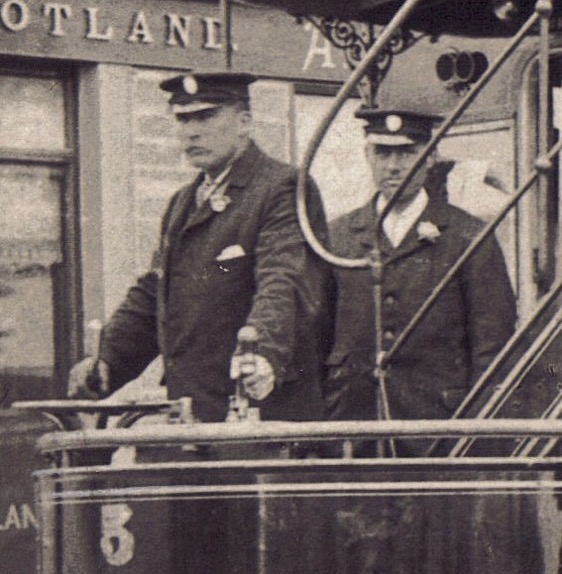
Another blow-up of the above photograph, this time showing the two figures on the platform. Both are wearing the same jackets and caps as the conductor. The man at the controls may well be undergoing driving instruction from the man behind him.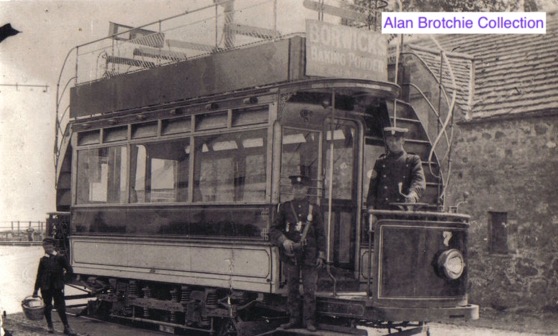
Tramcar No 7 and crew on the single track access to the depot at Milton — photo undated, but given the good condition of the vehicle, probably taken in the mid-to-late-Edwardian era.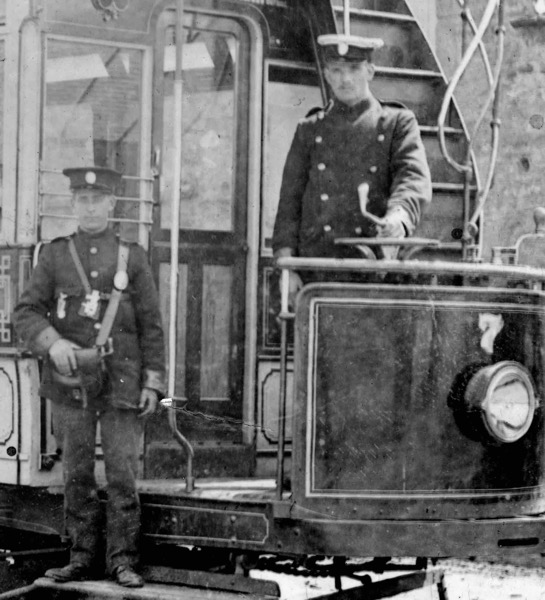
An enlargement of the above photograph showing the conductor and the motorman. Both men are wearing the tall oval cap badges seen earlier, but now with proper uniform jackets with metal buttons and epaulettes; the conductor is wearing a single-breasted jacket, the motorman a double-breasted, lancer-style tunic. The conductor's cash-bag strap once again clearly bears an oval plate. 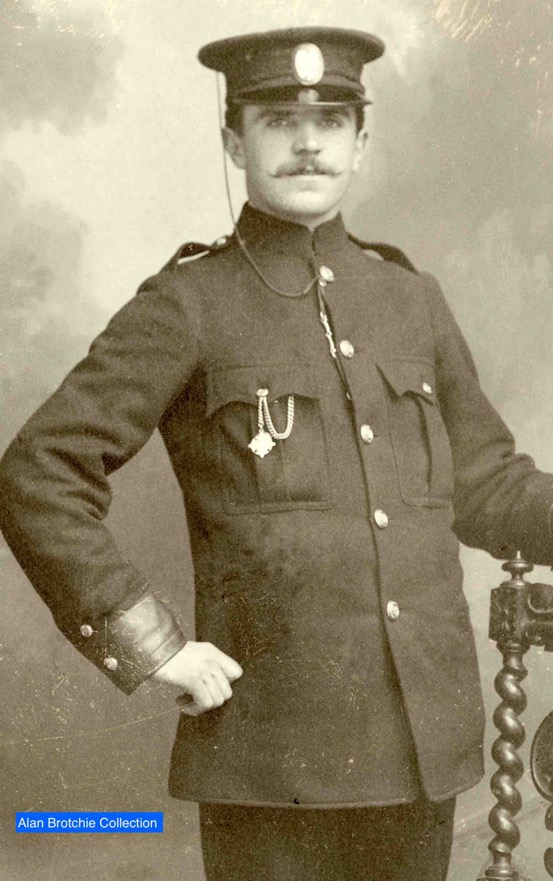
A rare studio portrait of a DBF&DTCo conductor — photo undated, but probably mid-to-late Edwardian. Magnification reveals the uniform buttons to be of the second design (see link)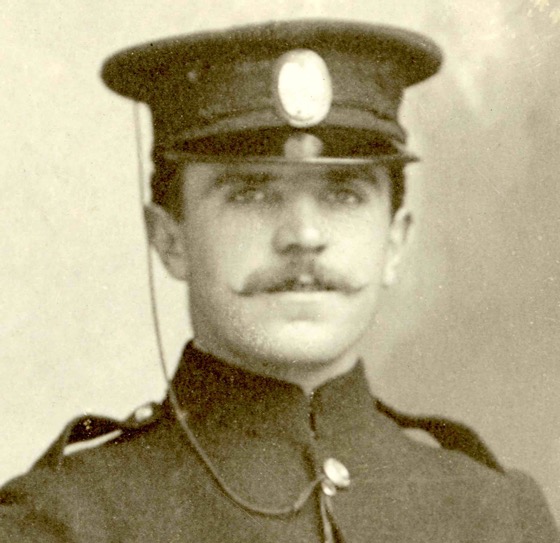
An enlargement of the above photograph showing the absence of collar and epaulette insignia, as well as the tall, oval cap badge. It is unclear whether the latter was plain metal or enamelled, no examples having survived.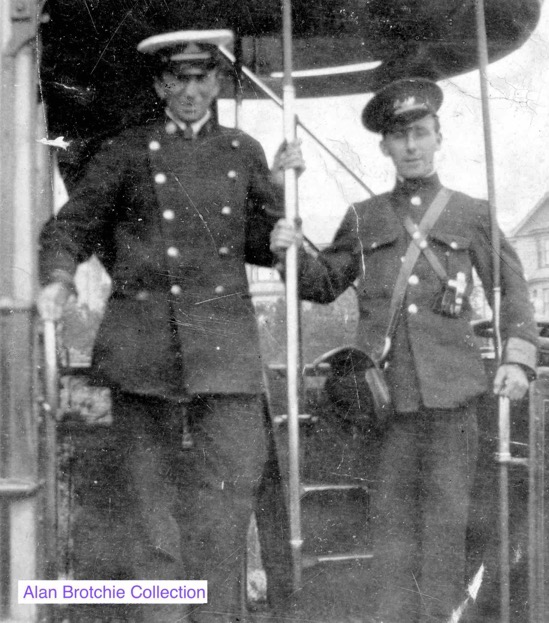
A motorman and his conductor stand on the platform of an unidentified tramcar — photo undated, but probably taken shortly after the Great War. By this time, the epaulettes had been dispensed with, and the tall, oval cap badges had been displaced by script-lettering grade badges. The motorman's cap bears what is probably a regimental badge, the wearing of which was common practice amongst tramway men and women across the British Isles during, and for a short time after, the Great War.
General pattern script-lettering cap badges — 'Motorman' and 'Conductor' — brass, of the type used by the DBF&DTCo from around the time of the Great War through to the closure of the system in 1931. Author's Collection.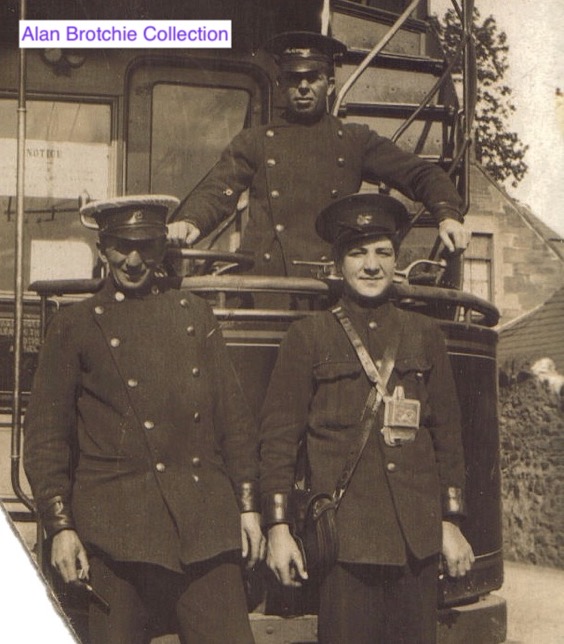
Two motormen and a conductor pose with a tramcar at the extension terminus at Tay Street, Monifieth — photo undated, but probably taken in the early 1920s. Although it is possible that the two individuals at the front are actually Dundee City Tramways employees, given that the service was operated by both the DBF&DTCo and the municipal undertaking, neither of their uniforms matches those worn by DCT staff during the 1920s, so all three are therefore almost certainly DBF&DTCo employees. The motorman's cap bears a script-lettering grade badge, in contrast to the two men at the front, whose caps bear what are, in all probability, regimental badges. The conductor's cash-bag strap does not have the oval plate seen in all other photographs.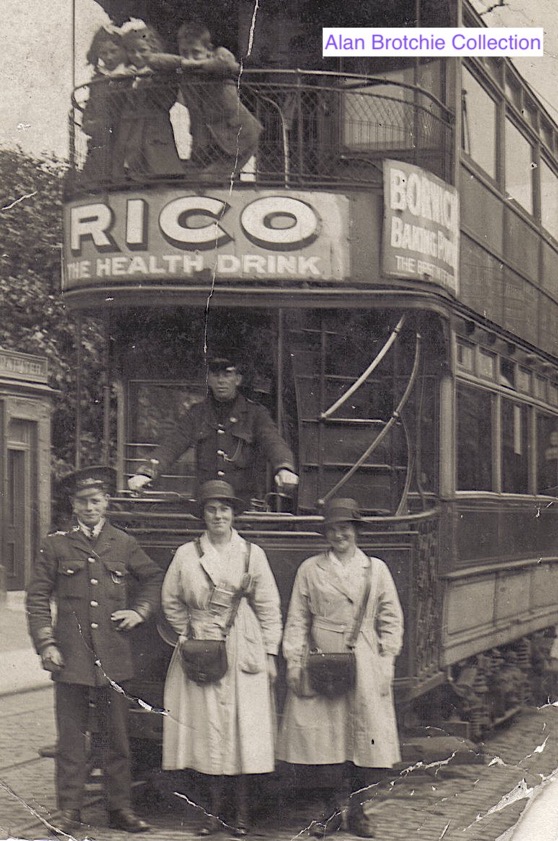
Four members of staff pose with an unidentified tramcar at Monifieth — photo undated, but probably taken in the late 1920s. The two motormen are wearing the last style of uniform issued by the company late in its life: single-breasted jackets with two breast pockets, lapels and epaulettes; as previously the jackets bear no insignia. Both of the men's caps bear script-lettering 'Motorman' grade badges. The two conductresses are wearing straw bonnets without badges, along with light-coloured, gabardine-style rain coats, indicating that it was summer. The lady on the left has the usual oval plate on her cash-bag strap.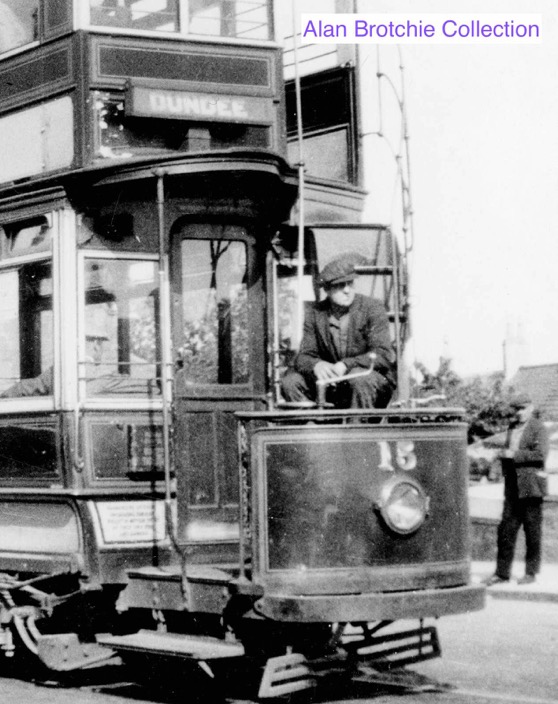
A motorman at the controls of ex-Dundee City Tramways Tramcar No 15, so definitely taken no earlier than 1926. He is almost certainly one of the depot staff filling in on driving duties due to a staff shortage. Photo believed to have been taken by Dr H A Whitcombe.
Senior staff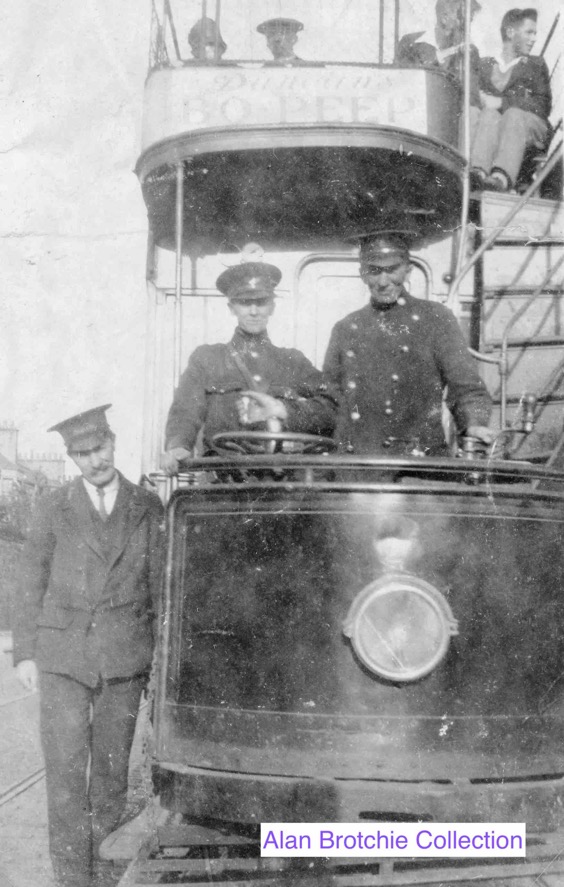
A DBF&DTCo inspector, believed to be a Mr Rennie, with a conductor and a motorman — photo undated, but thought to have been taken in the late 1920s. Mr Rennie is wearing a double-breasted jacket with lapels, the collars bearing his grade in embroidered script lettering, as does his cap.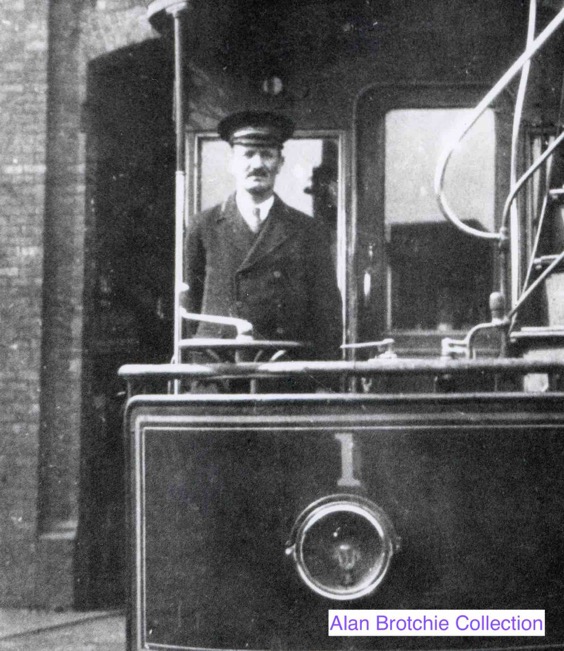
Mr Rennie again, this time with Tramcar No 1 outside the depot in the last week of operation (May 1931).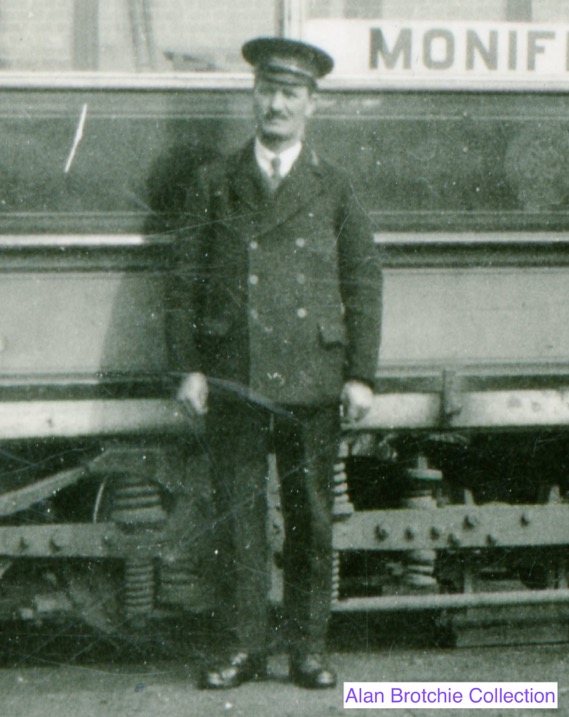
Another shot of Inspector Rennie, taken on the same day as the previous photograph.
Female staff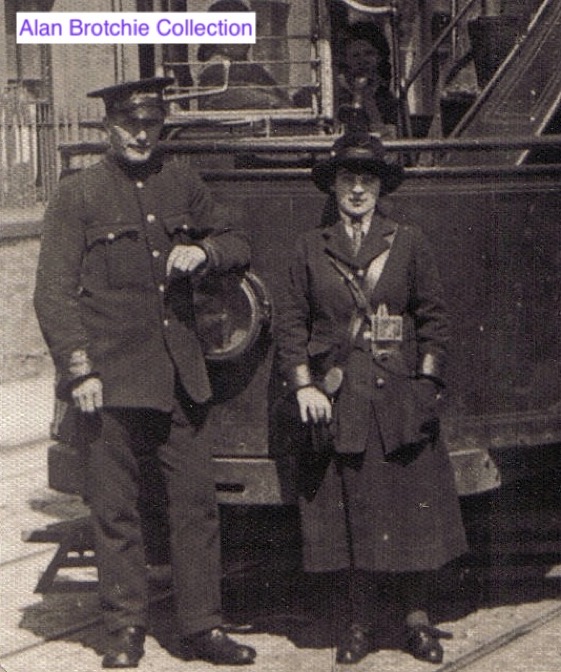
A motorman and a conductress pose with their tramcar at Monifieth — photo undated, but probably taken in the early 1920s. The motorman is wearing a single-breasted jacket of the type normally issued to conductors, all devoid of insignia; his cap however, clearly carries a script-lettering grade badge, 'Motorman'. The conductress is in a smart uniform comprising a single-breasted jacket with lapels, and a long matching skirt, all devoid of insignia. Her hat takes the form of a dark-coloured straw bonnet with a hat band, seemingly without a cap badge, though this cannot be stated with certainty. The oval plate on her cash-bag strap is just visible above her right hand. 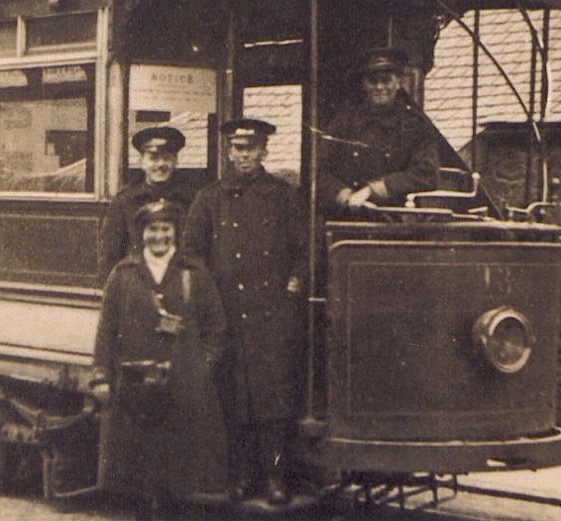
Four members of staff (probably two crews) pose on the platform of Tramcar No 13 — photo undated, but probably taken in the 1920s. Although not 100% certain, all would appear to be wearing script-lettering grade badges on their caps. It is almost certainly winter time (or what passes for spring/autumn in the British Isles), given that all are attired in heavy greatcoats with high, fold-over collars, the mens' double breasted and the lady's single breasted. Photo from the M H Waller Collection, courtesy of Alan Brotchie.